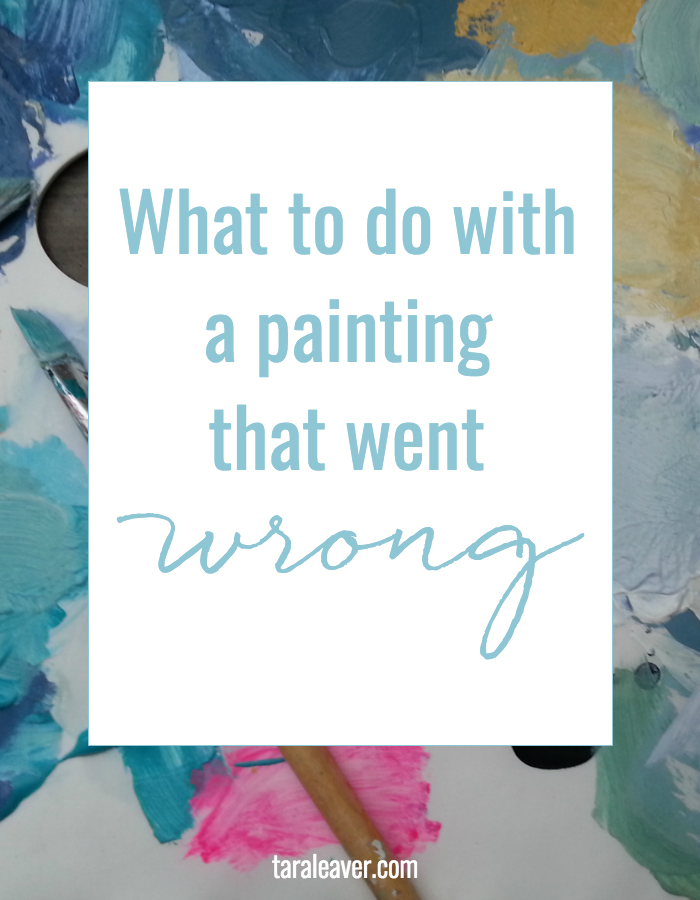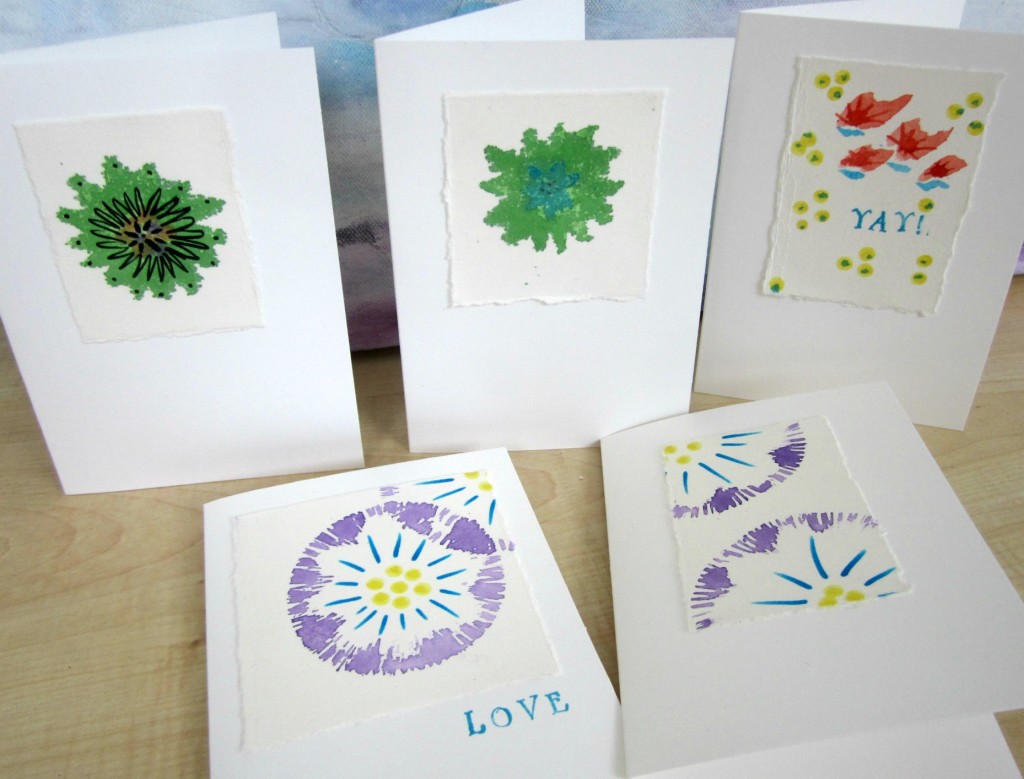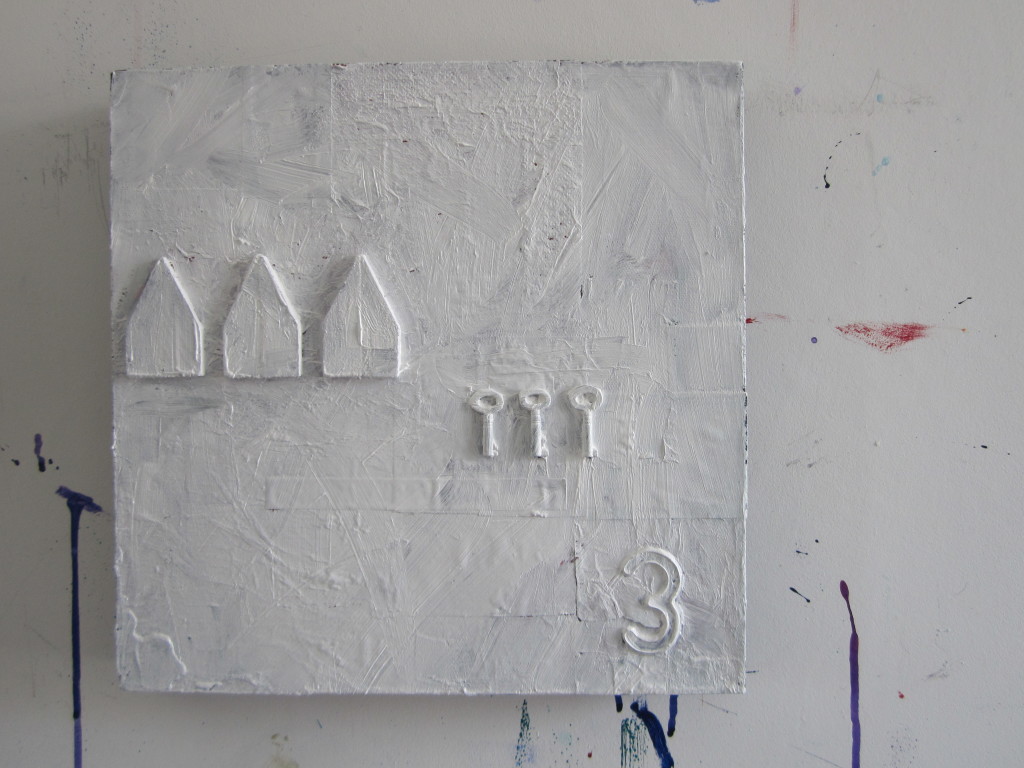It happens to everyone.
Sometimes a painting just doesn’t turn out the way we hoped, and seems to be a lost cause. And sometimes it really is, and we can just put it down to practice and experience and move on. {No mean self-directed comments about being a crap artist please. I’m pretty sure even Michelangelo had his off days.}
But other times there are things we can do to save our work.
The first question to always ask when things start going awry, is:
Is this just the Ugly Phase?
Show me a painter who doesn’t know from personal experience what I mean by that term and I’ll conjure a unicorn from thin air.
If it is simply that you have reached the Ugly Phase then that is good news; once you get past the initial ‘this is a disaster… what the hell do I do now?’, it is great practice in trusting the process and adding persistence and patience to your repertoire of worthy values. 😉
If your painting is on paper it’s perfect; just cut it into smaller pieces and make cards or other kinds of mini art from it {ATCs, affirmation or inspiration cards, tags for gifts etc}.
There is something about a disaster painting cut into smaller pieces that suddenly renders each one beautiful.
If your painting is on a stretched canvas, you may like to consider gessoing over the entire thing and using whatever you already have down as a textural starting point.
And you know what? Sometimes it’s ok to just bin it.
My art teacher at school always told us never to throw any of our work away, and up to a point there is value in keeping it to see your progress, or use as inspiration later on.
But if you’re just too bummed out with it, and there’s no inspiration to save it, let it go.
It’s just a painting. You can always do another one.










Ha ha. I have absolutely done 2 and 3! Good to know that people who make beautiful art on a regular basis also have their ‘ugly’ paintings. I have not yet painted on paper but really love the idea of cutting it up.. Sounds therapeutic as well as innovative.
I know people say this all the time but it really is a part of the process. It’s how we learn and without making detours down paths we don’t like we wouldn’t have such an indepth understanding of what we do, and most likely a much smaller range of techniques to play with. We’ll be painting on paper in the course so that’ll get you started! 🙂
One way that often works for me, beside the ones you mention, is to put it a way for a couple of days and then look at it with fresh eyes. Also, I have often had to let go of what I thought the pictures should look like and let whatever wants to come through be expressed. I am just learning and have had three paintings turn out very different from my orginal vision. I love the outcomes now. I used to have such a hard time with the ‘ugly phase’ and destroyed a lot of pictures now I just try to be patient! Thanks for a really good post.
That’s a good one Leone, I do that too but didn’t think of it when I wrote the post. Some of mine get left for months before I revisit them with fresh energy. And I agree letting go of the outcome is a huge pressure reliever and also allows for all sorts of interesting things to happen.
I never used to be afraid to make bad paintings until I had to start tracking inventory for taxes! I just don’t know what to do with those wasted items. Sometimes I cut things up and put them in my journals when I want to write but don’t feel like decorating the page.
I had a big stack of 4′ canvases that were such a pain to move home to home, and have to store in our tiny living spaces. They weren’t even useful paintings to me, just studies. Every time I moved them, there was more torn edges and more paint rubbed off that I eventually got fed up and cut them all off of their supports. Kept the ones I was proud of, chopped up and tossed the ones I hated! Felt so much better!!
I still have a few huge pieces I don’t know what to do with because they’re on that awful canvas board stuff, yeesh. At least the others I could roll up and store in a travel tube.
Yes, nothing like some outside pressure to make you feel like everything you produce must be amazing Melissa! I really like the idea of adding them to journals as ready made backgrounds, that’s a great solution. Also cutting the canvases off the stretchers; I bet that was a bit scary in the moment but such a good idea from the storage perspective to reuse as well!
And I hear you on the canvas board! Hate it!
Paintings can go majorly wrong. I used to just put them away and ignore them for years. But I recently started working over them, even the ones with textures and 3D elements, like you show here. And I find that I’ve been invigorated by these reworkings!
i love this Tara. Who hasn’t fucked up a painting now & then? Yes, even Michelangelo had his off days. I love what you did with the blue one – all those cards. And i think each card looks fabulous (even if you didn’t like the painting). Wonderful ideas here. And that white one with the 3 little houses & keys… love LOVE. xox
Thanks for the words of wisdom Tara! So what do you do with a painting you used to like but just don’t feel anymore? Cover it up and start over or recognize that it was good when you did and and you’ve just moved on (and force it on to your loved ones to hang instead)??
Oh yes, I have plenty of those! It’s funny, I always feel I’m betraying them slightly by not loving them any more. Sometimes I paint over them, but some I just keep in an open ended kind of way. If someone loves one of those ones I’m happy to make them a gift.
hey you…
when you say: “If your painting is on paper it’s perfect;”… what kind of paper are you referencing? i have pretty much only ever used canvas (though i do think i may have some watercolor paper and drawing paper somewhere… are those the types you mean here?) 🙂
Great question! I’ve tried a lot of different types of paper over the years, and I find the best for the kind of layering/collage/heavy application that I like requires paper of around 200gsm or higher {it will usually tell you on the front of a pad what gsm it is}. If you’re using watercolour and lighter washes, watercolour paper is obviously great. It can also be thick enough for acrylics but I find the surface isn’t smooth enough. Normal sketchbook paper will tend to buckle or even tear if you’re doing a lot of layers or using a lot of water, so rule of thumb for me is, the thicker and smoother the better! Bristol board is great as it is both thicker and smooth.
Hi Tara, I have been writing about the ‘ugly phase’ too and linked to this post which I thought was so useful and insightful. Here’s the link to my post: http://janehinchliffe.com/ugly-phase-painting/
That link takes me to a 404 page. 🙂
Hi Tara, not sure what’s been happening from a tech point of view with my link but I just tried the link to my blog post now and it seems fine from my end. Thanks, Jane. 🙂
Turn the painting upside down, and start working on it again. It might help.
Yes that’s always a good idea. 🙂
Hi Tara. A couple of years ago I had a massive canvas that went “Ugly” in such a way that it spend the most of its days and years behind a huge cupboard. By referring to the “ugly” it was really – really bad in such a big way that I completely stopped painting for five years. I just had no desire to paint again. In any way I spoke to a friend of mine who’s husband turned out also to be an artist and she mentioned that he re-used his old canvasses. At first I was totally blown away by the idea and asked “how on earth?” Then she mentioned that he preferred to paint with acrylics and that he would sand it lightly with sandpaper till smooth and then just cover the entire canvas with white PVA and then sand it lightly again when dry. I mentioned this to my husband and he decided that he will try this and told me straight that I needed to paint again. Within a day I had a beautiful clean canvas and could paint again. Since then I do not worry about expensive canvasses going to waste. IT works and should you even do a landscape it gives a rough texture to the canvas when not totally sanded after the PVA overlay. Thanks for all the wonderful tips. All the way from South Africa. 🙂
Interesting! I wouldn’t have thought of painting it over with PVA. I usually use gesso. 🙂
I have a Pleinair painting I just did. It is so dark! It’s acrylic. Should I just gesso it’s? Or lighten it somehow? Or paint over it in oil? Help!
Hi Heather – If you want to lighten it up without resorting to gesso and losing what you’ve already got down, try mixing up lighter versions of the colours you’ve already used and laying them over bit by bit. You can use white/gesso to lighten them but this will create pastel/opaque versions of the colours; you can also use lighter colours to lighten them. So for example if you have a dark green, you could try adding yellow to lighten it up. This will also mean more diversity and subtlety in the final painting. Another thing you can do is go back in towards the end with lighter coloured oil pastels or Neocolours to create highlights. Hope that helps!